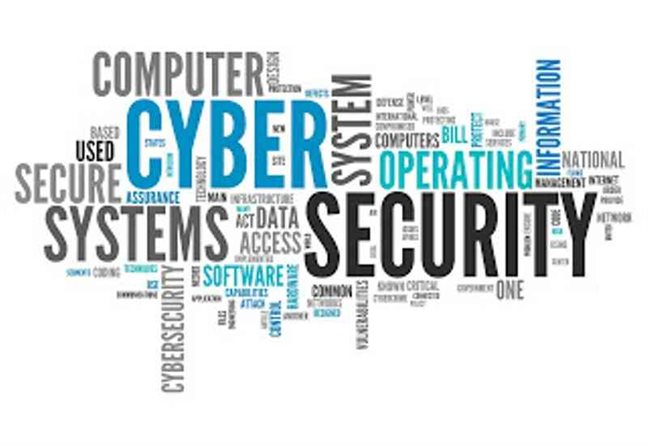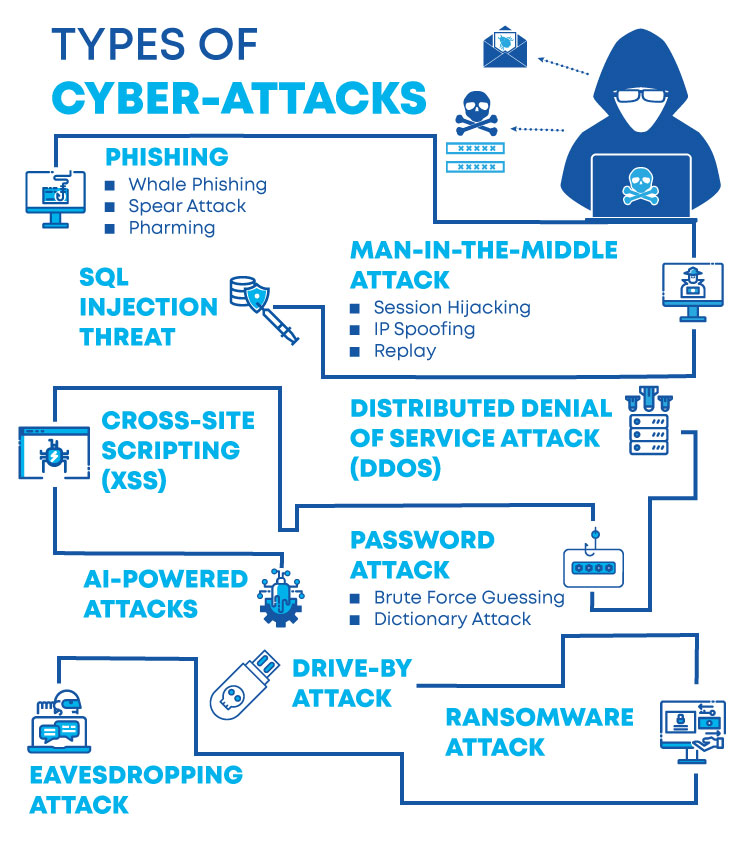Cyber security is the state or process of protecting and recovering networks, devices and programs from any type of cyberattack.
Cyber security refers to the body of technologies, processes, and practices designed to protect networks, devices, programs, and data from attack, damage, or unauthorized access. Cyber security may also be referred to as information technology security.
Types of cyber threats:
1. Cybercrime includes single actors or groups targeting systems for financial gain or to cause disruption.
2. Cyber-attack often involves politically motivated information gathering.
3. Cyberterrorism is intended to undermine electronic systems to cause panic or fear.
So, how do malicious actors gain control of computer systems? Here are some common methods used to threaten cyber-security:
Malware:
Malware means malicious software. One of the most common cyber threats, malware is software that a cybercriminal or hacker has created to disrupt or damage a legitimate user’s computer. Often spread via an unsolicited email attachment or legitimate-looking download, malware may be used by cybercriminals to make money or in politically motivated cyber-attacks.
There are a number of different types of malware, including:
· Virus: A self-replicating program that attaches itself to clean file and spreads throughout a computer system, infecting files with malicious code.
· Trojans: A type of malware that is disguised as legitimate software. Cybercriminals trick users into uploading Trojans onto their computer where they cause damage or collect data.
· Spyware: A program that secretly records what a user does, so that cybercriminals can make use of this information. For example, spyware could capture credit card details.
· Ransomware: Malware which locks down a user’s files and data, with the threat of erasing it unless a ransom is paid.
· Adware: Advertising software which can be used to spread malware.
· Botnets: Networks of malware infected computers which cybercriminals use to perform tasks online without the user’s permission.
SQL injection:An SQL (structured language query) injection is a type of cyber-attack used to take control of and steal data from a database. Cybercriminals exploit vulnerabilities in data-driven applications to insert malicious code into a databased via a malicious SQL statement. This gives them access to the sensitive information contained in the database.
Phishing:Phishing is when cybercriminals target victims with emails that appear to be from a legitimate company asking for sensitive information. Phishing attacks are often used to dupe people into handing over credit card data and other personal information.
Man-in-the-middle attack:A man-in-the-middle attack is a type of cyber threat where a cybercriminal intercepts communication between two individuals in order to steal data. For example, on an unsecure WiFi network, an attacker could intercept data being passed from the victim’s device and the network.
Denial-of-service attack
A denial-of-service attack is where cybercriminals prevent a computer system from fulfilling legitimate requests by overwhelming the networks and servers with traffic. This renders the system unusable, preventing an organization from carrying out vital functions.
THE IMPORTANCE OF CYBER SECURITY:
 Cyber security is important because government, military, corporate, financial, and medical organizations collect, process, and store unprecedented amounts of data on computers and other devices. A significant portion of that data can be sensitive information, whether that be intellectual property, financial data, personal information, or other types of data for which unauthorized access or exposure could have negative consequences. Organizations transmit sensitive data across networks and to other devices in the course of doing businesses, and cyber security describes the discipline dedicated to protecting that information and the systems used to process or store it. As the volume and sophistication of cyber attacks grow, companies and organizations, especially those that are tasked with safeguarding information relating to national security, health, or financial records, need to take steps to protect their sensitive business and personnel information. As early as March 2013, the nation’s top intelligence officials cautioned that cyber attacks and digital spying are the top threat to national security, eclipsing even terrorism.
Cyber security is important because government, military, corporate, financial, and medical organizations collect, process, and store unprecedented amounts of data on computers and other devices. A significant portion of that data can be sensitive information, whether that be intellectual property, financial data, personal information, or other types of data for which unauthorized access or exposure could have negative consequences. Organizations transmit sensitive data across networks and to other devices in the course of doing businesses, and cyber security describes the discipline dedicated to protecting that information and the systems used to process or store it. As the volume and sophistication of cyber attacks grow, companies and organizations, especially those that are tasked with safeguarding information relating to national security, health, or financial records, need to take steps to protect their sensitive business and personnel information. As early as March 2013, the nation’s top intelligence officials cautioned that cyber attacks and digital spying are the top threat to national security, eclipsing even terrorism.CHALLENGES OF CYBER SECURITY:
For an effective cyber security, an organization needs to coordinate its efforts throughout its entire information system. Elements of cyber encompass all of the following:
- Network security: The process of protecting the network from unwanted users, attacks and intrusions.
- Application security: Apps require constant updates and testing to ensure these programs are secure from attacks.
- Endpoint security: Remote access is a necessary part of business, but can also be a weak point for data. Endpoint security is the process of protecting remote access to a company’s network.
- Data security: Inside of networks and applications is data. Protecting company and customer information is a separate layer of security.
- Identity management: Essentially, this is a process of understanding the access every individual has in an organization.
- Database and infrastructure security: Everything in a network involves databases and physical equipment. Protecting these devices is equally important.
- Cloud security: Many files are in digital environments or “the cloud”. Protecting data in a 100% online environment presents a large amount of challenges.
- Mobile security: Cell phones and tablets involve virtually every type of security challenge in and of themselves.
- Disaster recovery/business continuity planning: In the event of a breach, natural disaster or other event data must be protected and business must go on. For this, you’ll need a plan.End-user education: Users may be employees accessing the network or customers logging on to a company app. Educating good habits (password changes, 2-factor authentication, etc.) is an important part of cybersecurity.
The most difficult challenge in cyber security is the ever-evolving nature of security risks themselves. Traditionally, organizations and the government have focused most of their cyber security resources on perimeter security to protect only their most crucial system components and defend against known treats. Today, this approach is insufficient, as the threats advance and change more quickly than organizations can keep up with. As a result, advisory organizations promote more proactive and adaptive approaches to cyber security. Similarly, the National Institute of Standards and Technology issued guidelines in its risk assessment framework that recommend a shift toward continuous monitoring and real-time assessments, a data-focused approach to security as opposed to the traditional perimeter-based model.
MANAGING CYBER SECURITY:
 The National Cyber Security Alliance, recommends a top-down approach to cyber security in which corporate management leads the charge in prioritizing cyber security management across all business practices. NCSA advises that companies must be prepared to “respond to the inevitable cyber incident, restore normal operations, and ensure that company assets and the company’s reputation are protected.” NCSA’s guidelines for conducting cyber risk assessments focus on three key areas: identifying your organization’s “crown jewels,” or your most valuable information requiring protection; identifying the threats and risks facing that information; and outlining the damage your organization would incur should that data be lost or wrongfully exposed. Cyber risk assessments should also consider any regulations that impact the way your company collects, stores, and secures data, such as PCI-DSS, HIPAA, SOX, FISMA, and others. Following a cyber risk assessment, develop and implement a plan to mitigate cyber risk, protect the “crown jewels” outlined in your assessment, and effectively detect and respond to security incidents. This plan should encompass both the processes and technologies required to build a mature cyber security program. An ever-evolving field, cyber security best practices must evolve to accommodate the increasingly sophisticated attacks carried out by attackers. Combining sound cyber security measures with an educated and security-minded employee base provides the best defense against cyber criminals attempting to gain access to your company’s sensitive data. While it may seem like a daunting task, start small and focus on your most sensitive data, scaling your efforts as your cyber program matures.
The National Cyber Security Alliance, recommends a top-down approach to cyber security in which corporate management leads the charge in prioritizing cyber security management across all business practices. NCSA advises that companies must be prepared to “respond to the inevitable cyber incident, restore normal operations, and ensure that company assets and the company’s reputation are protected.” NCSA’s guidelines for conducting cyber risk assessments focus on three key areas: identifying your organization’s “crown jewels,” or your most valuable information requiring protection; identifying the threats and risks facing that information; and outlining the damage your organization would incur should that data be lost or wrongfully exposed. Cyber risk assessments should also consider any regulations that impact the way your company collects, stores, and secures data, such as PCI-DSS, HIPAA, SOX, FISMA, and others. Following a cyber risk assessment, develop and implement a plan to mitigate cyber risk, protect the “crown jewels” outlined in your assessment, and effectively detect and respond to security incidents. This plan should encompass both the processes and technologies required to build a mature cyber security program. An ever-evolving field, cyber security best practices must evolve to accommodate the increasingly sophisticated attacks carried out by attackers. Combining sound cyber security measures with an educated and security-minded employee base provides the best defense against cyber criminals attempting to gain access to your company’s sensitive data. While it may seem like a daunting task, start small and focus on your most sensitive data, scaling your efforts as your cyber program matures.
Comments
Post a Comment